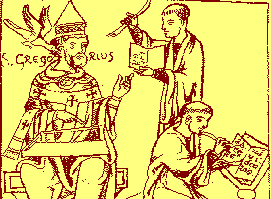The Average Nobleperson’s Guide to Early Music Recordings
Part I
The Cantigas de Santa Maria
– or –
It Has A Good Beat And I Can Genuflect To It
by Lord Samuel Piper
Gregorian Chant
So I am writing a series of discussions of medieval and renaissance music that I think may appeal to people who actually like music (defined by me to be “stuff I like to hear”). To begin, I wish to recommend recordings of certain works that are important and well-known representatives of their periods; the Medieval Top 40, if you will.
Las Cantigas de Santa Maria
Let us start with one of the most important works of medieval music, Las Cantigas de Santa Maria, or the Songs of Saint Mary.
The Cantigas de Santa Maria were commissioned by Alfonso X (1221-1284), king of Castile and Leon. Alfonso was a great lover of the arts, which eventually won him the title of El Sabio, or the Wise. Alfonso served as patron and protector of many Italian and Provencal troubadours visiting his court, who were avoiding persecution by the Inquisition (which nobody expected, after all).
No accompaniment, harmonies or instructions on how to perform these songs were every written down so far as we know. In fact, the notation employed to transcribe the melodies, resembling flags and slanting lines, leaves them open to rhythmic interpretation as well. When modern musicians sing and play these pieces, they make assumptions based on the type of musical influences at work in Alfonso’s court: middle-eastern rhythms and modes as well as French and central European styles. Therefore different performances of the same piece may vary a lot.
My favorite recording of these cantigas is by the Waverly Consort, Las Cantigas de Santa Maria, Vanguard CD OVC 2013. In this recording, a troubadour narrates the music in English, pronouncing the prologue and an exposition for each cantiga before the song is performed. Since the songs are sung in their original Galician-Portugese, the expositions help you to understand the songs, such as explaining what happened to the ill-advised priest who made underwear out of an altar cloth dedicated to Mary. I warn you; don’t buy any boxers with halos on them. This CD is very theatrical and feels like a performance as it might have been before the court, except without the belly dancers. The Waverly Consort employs both female and male voices (which was probably authentic, as Alphonso did employ female musicians), as well as many of the instruments shown in the Cantigas manuscript. This is a mid-price CD; about $13.
A different approach to the cantigas is taken in the CD Visions and Miracles, by the Ensemble Alcatraz, Nonesuch CD 9 79180-2. They perform only 6 cantigas, as well as 2 songs from Las Huelgas Codex, another source of 13th century songs. They elaborate and expand on the original melodies, but only one of the cantigas is a skip-button-provoking 14 minutes long. The Ensemble Alcatraz uses a lovely female voice for all the solos, occasionally using male voices as well in chorus. They perform with mostly bowed string accompaniment, which gives the CD a lush, but sometimes restrained and homogenous sound. This is a full price CD, running about $16.
Yet another approach is taken by the Ensemble Unicorn, Vienna, on its CD Alfonso X: Cantigas de Santa Maria, Naxos CD 8.553133. Their approach is a little more Arabian – the instruments are varied more and they perform with more abandon, leading to some wild middle-eastern riffs reminiscent of drug-induced solos of any dead rock musician of your choice. Like the Waverly Consort, the Ensemble Unicorn performs the prologue, although they use the untranslated Galician-Portugese and do not read the expositions to the individual cantigas. The ensemble performs with a bevy of instruments and 2 male voices, although one is a counter-tenor, which is a man singing in the soprano range as if certain body parts are unnaturally constricted, but without the resultant cracked notes and tears. While the CD notes are good, there are no lyrics or translations printed, so you may not have any idea what each cantiga is about. But then, this is a budget CD, costing only $6.
All of these CDs are good and well worth owning. One of the nice things about the Cantigas de Santa Maria is that, with over 400 songs, you can buy a lot of recordings of them and never worry about getting all the same pieces again. Then again, some are duplicated even on these 3 CDs, as some cantigas are very popular and are frequently recorded – The Virgin’s Greatest Hits.


